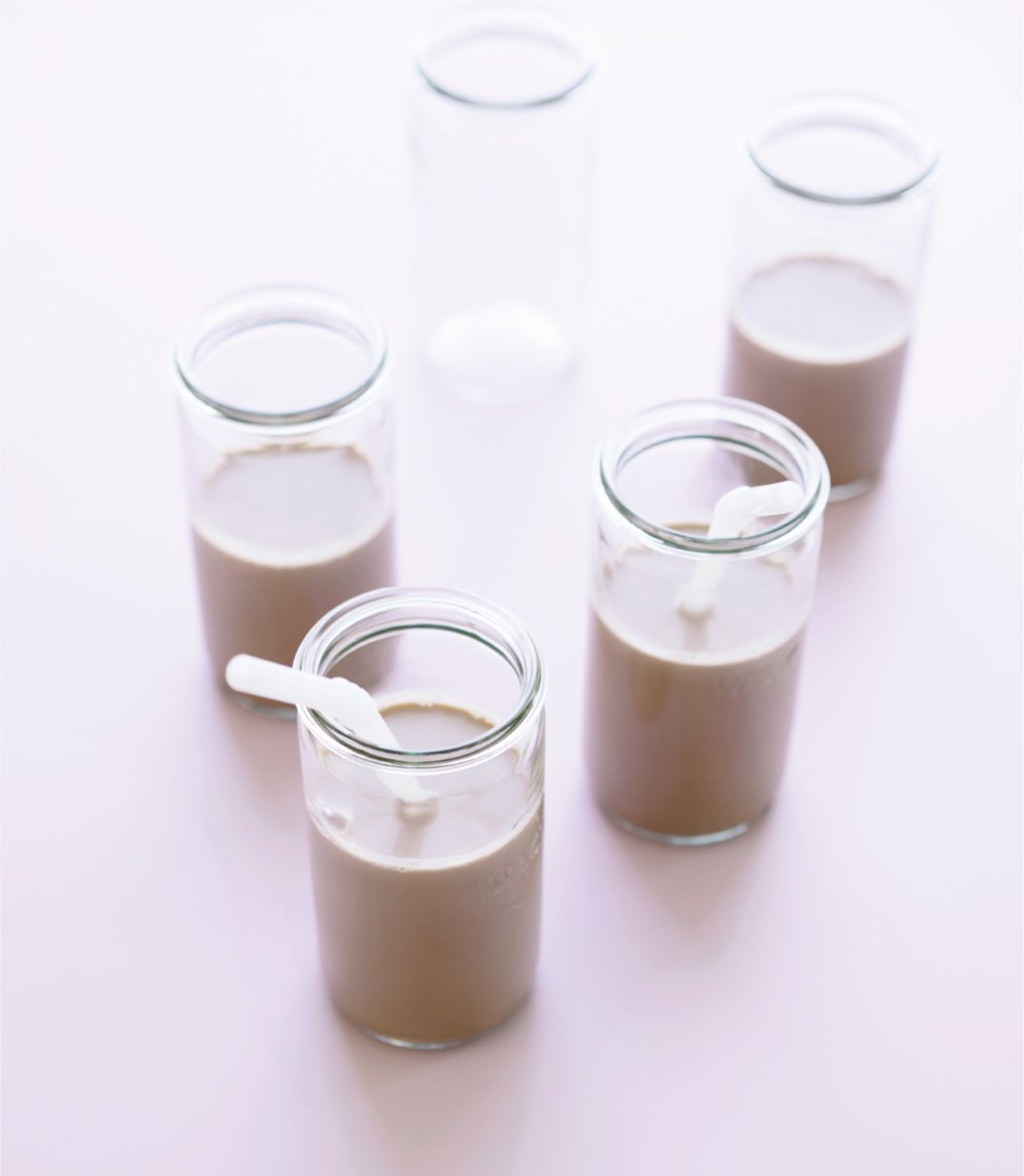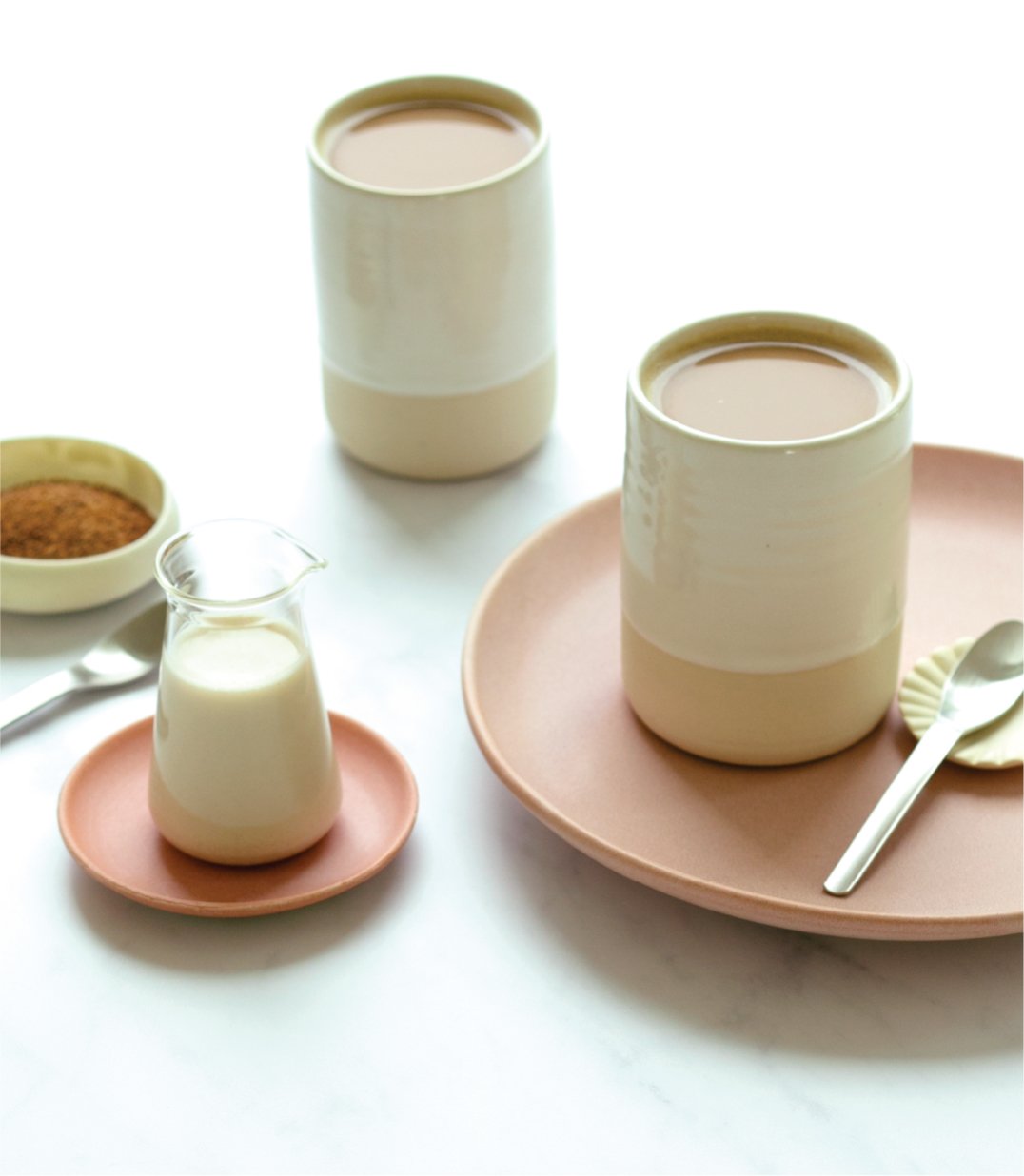Articles
Making Plant-Based Milks at Home
The core of our mission is to make plant-based living easier and more enjoyable. Our Nama juicers have helped hundreds of thousands of people add more fruits and vegetables to their lives, and now we are excited to help others add even more plant variety by creating a plant-based milk maker, the Nama M1.
Yes, there are other ways to make plant-based milk at home—and we’ve tried them all—but they miss the mark on creating the best flavor and texture. While you can make plant milks in the Nama J2, we saw an opportunity to create a product that produced even better flavor in a faster, more efficient way. Don’t worry, the J2 is still a great option, but the M1 consistently makes creamier, barista-style milks without the need to soak the ingredients ahead of time.
We’ve seen the popularity of plant-based milks explode over the past 10 years—there are currently hundreds of store-bought brands available. Given this rise in popularity, we knew it was worthwhile to create a way to make them easy and enjoyable at home.

THE BENEFITS OF MAKING PLANT-BASED MILKS AT HOME
Just like making fresh cold-pressed juice, there are so many benefits to making your own plant-based milks, too. Experimenting with different types of plant-based milks with minimal ingredients may help you mix up your vitamin and mineral intake. When you make your own plant-based beverage at home, you can enjoy freshly made milk from nuts, grains, or seeds. Plus, you’ll always know exactly what you are putting into the drink, including any simple flavorings, like vanilla or dates, that work with your taste and health preferences.
Here are some benefits of making plant-based milk at home:
Choose Your Ingredients
Many store-bought milks contain ingredients that might sound unfamiliar to you. These unwanted ingredients include lecithins, gellan gum, carrageenan, guar gum, locust bean gum, xanthan gum, cane sugar, agave syrup, stevia, natural flavors, or seed oils. Making plant-based milk at home allows you to decide what goes in your milk without the need for unnecessary chemicals to make their shelf life longer.
More Cost Effective
Affordable plant-based milk is possible and easy to achieve. When you make your own nut milk at home, you can source the nuts, seeds, and grains that work for your nutrition needs and your wallet instead of spending more buying cartons and cartons of nut milk at the store. Depending on the type of milk, making it at home can save up to 70 percent compared to buying store-bought milks. You can also shop sales or buy the ingredients in bulk for even more savings.
Better for Environment
As for sustainability, plant-based milks are a better choice for those concerned about the environment. The dairy industry accounts for about 2 percent of all U.S. greenhouse gas emissions. In addition, cow’s milk requires large amounts of water with an estimated 144 gallons of water to produce just 1 gallon of milk. Almond milk has also received a lot of attention for its large water footprint, but in comparison, one study found that it takes about 3.2 gallons of water to produce one almond, and estimates show that it takes about 84 gallons of water to make a gallon of almond milk. If you are concerned about water usage, choose oats or seeds (pumpkin or sunflower) as those processes tend to use less. Consider opting for organic ingredients to reduce the use of pesticides or herbicides.
Pulp Utilization
Making milk at home can be part of living a zero-waste lifestyle. You can add the pulp to smoothies for a boost of fiber, or leftover pulp can be used in various recipes like pancakes, muffins, no-bake desserts, or stored for later use. If you don’t have time to use the pulp immediately, you can store it in the fridge or freezer until you are ready. If you’re not a fan of reusing your pulp, you can always compost it. Learn more about composting here.
Fresh Ingredients, Better Flavor
Homemade plant-based milk is fresher compared to store-bought varieties, as it does not contain preservatives or additives that are needed to maintain shelf life. This can result in a deeper flavor and potentially higher nutrient content. You will taste the sweetness and richness of your nuts and seeds when they are made fresh. Even low-ingredient store-bought milk has gone through pasteurization or some type of high-temperature processing.
Choose Your Ingredients
Many store-bought milks contain ingredients that might sound unfamiliar to you. These unwanted ingredients include lecithins, gellan gum, carrageenan, guar gum, locust bean gum, xanthan gum, cane sugar, agave syrup, stevia, natural flavors, or seed oils. Making plant-based milk at home allows you to decide what goes in your milk without the need for unnecessary chemicals to make their shelf life longer.
More Cost Effective
Affordable plant-based milk is possible and easy to achieve. When you make your own nut milk at home, you can source the nuts, seeds, and grains that work for your nutrition needs and your wallet instead of spending more buying cartons and cartons of nut milk at the store. Depending on the type of milk, making it at home can save up to 70 percent compared to buying store-bought milks. You can also shop sales or buy the ingredients in bulk for even more savings.
Better for Environment
As for sustainability, plant-based milks are a better choice for those concerned about the environment. The dairy industry accounts for about 2 percent of all U.S. greenhouse gas emissions. In addition, cow’s milk requires large amounts of water with an estimated 144 gallons of water to produce just 1 gallon of milk. Almond milk has also received a lot of attention for its large water footprint, but in comparison, one study found that it takes about 3.2 gallons of water to produce one almond, and estimates show that it takes about 84 gallons of water to make a gallon of almond milk. If you are concerned about water usage, choose oats or seeds (pumpkin or sunflower) as those processes tend to use less. Consider opting for organic ingredients to reduce the use of pesticides or herbicides.
Pulp Utilization
Making milk at home can be part of living a zero-waste lifestyle. You can add the pulp to smoothies for a boost of fiber, or leftover pulp can be used in various recipes like pancakes, muffins, no-bake desserts, or stored for later use. If you don’t have time to use the pulp immediately, you can store it in the fridge or freezer until you are ready. If you’re not a fan of reusing your pulp, you can always compost it. Learn more about composting here.
Fresh Ingredients, Better Flavor
Homemade plant-based milk is fresher compared to store-bought varieties, as it does not contain preservatives or additives that are needed to maintain shelf life. This can result in a deeper flavor and potentially higher nutrient content. You will taste the sweetness and richness of your nuts and seeds when they are made fresh. Even low-ingredient store-bought milk has gone through pasteurization or some type of high-temperature processing.

PERSONALIZING HOMEMADE PLANT-BASED MILKS
When you make plant-based milk at home, there are many ways to customize a recipe to suit your own preferences based on your health goals and preferred flavors. Here are a few suggestions for creating a milk that’s perfect for you:
High Protein
Use almonds, pistachios, hemp, or pumpkin seeds to boost the protein content in your milk.
Rich & Creamy
For a creamier milk texture, both macadamia nuts and coconut can provide a high ratio of healthy fats to create a rich, decadent drink.
Fruity
Adding fresh or frozen fruit can be a delicious way to increase essential nutrients in your milk. Experiment with strawberry, banana, and mango.
Calm & Comforting
Infuse your milk with adaptogenic herbs and spices to help soothe your system, such as lavender, cardamom, or chamomile.
Nourishing & Nutrient-Dense
Combine a mix of nuts, seeds, and grains for a greater variety of nutrients such as Brazil nuts and pumpkin seeds or flax and pistachio.
Anti-Inflammatory
Supercharge your milk by adding fresh ginger or turmeric to create a drink with brain-boosting and anti-inflammatory properties.
Sweet Treat
Try enhancing your recipe with natural sweeteners such as dates, raw honey, or maple syrup to enjoy a dessert-like drink.
Coffee Creamer
Achieve silky coffee creamer at home by simply reducing the liquid in your recipe and choosing a higher-fat base, such as coconut or cashew.
Barista-Style Quality
Adding more fat with a touch of coconut oil, along with having more nuts in the milk, creates a creamier, fluffier foam that can top coffee, matcha, and more.
Allergen-Friendly
Customize your milk to fit your specific needs. Nut-free: try sesame or hemp seeds. Keto: try coconut. Gluten-free: try certified gluten-free rice or oats.
High Protein
Use almonds, pistachios, hemp, or pumpkin seeds to boost the protein content in your milk.
Rich & Creamy
For a creamier milk texture, both macadamia nuts and coconut can provide a high ratio of healthy fats to create a rich, decadent drink.
Fruity
Adding fresh or frozen fruit can be a delicious way to increase essential nutrients in your milk. Experiment with strawberry, banana, and mango.
Calm & Comforting
Infuse your milk with adaptogenic herbs and spices to help soothe your system, such as lavender, cardamom, or chamomile. Nourishing & Nutrient-Dense: Combine a mix of nuts, seeds, and grains for a greater variety of nutrients such as Brazil nuts and pumpkin seeds or flax and pistachio.
Nourishing & Nutrient-Dense
Combine a mix of nuts, seeds, and grains for a greater variety of nutrients such as Brazil nuts and pumpkin seeds or flax and pistachio.
Anti-Inflammatory
Supercharge your milk by adding fresh ginger or turmeric to create a drink with brain-boosting and anti-inflammatory properties.
Sweet Treat
Try enhancing your recipe with natural sweeteners such as dates, raw honey, or maple syrup to enjoy a dessert-like drink.
Coffee Creamer
Achieve silky coffee creamer at home by simply reducing the liquid in your recipe and choosing a higher-fat base, such as coconut or cashew.
Barista-Style Quality
Adding more fat with a touch of coconut oil, along with having more nuts in the milk, creates a creamier, fluffier foam that can top coffee, matcha, and more.
Allergen-Friendly
Customize your milk to fit your specific needs. Nut-free: try sesame or hemp seeds. Keto: try coconut. Gluten-free: try certified gluten-free rice or oats.
M1 PLANT-BASED MILK, RECIPE SPOTLIGHT

CHOCOLATE HAZELNUT MILK
Makes: 4 1/2 cups
Hazelnuts and chocolate are an iconic pairing that might remind you of an Italian dessert. The sweet, nutty, rich, chocolate flavor makes this milk one of our favorites.
- 1 cup hazelnuts
- 1/4 cup cacao powder
- 3 tablespoons maple syrup (or 3 pitted dates)
- 1 pinch sea salt
- 4 cups water
DIRECTIONS
- Using the Nama M1 Plant-Based Milk Maker, check that the spout cap is closed, then add all ingredients into the filter basket.
- Secure the lid and set the blending time to 1 minute. Press Start.
- Follow prompts to open the spout, after 10 seconds the spin cycle will activate. Once this is finished, your milk is ready to enjoy.

ALMOND, OAT MAPLE CREAMER
Makes: 2 1/2 cups
Softly sweet, rich, and smooth, this creamer blends almonds and oats to give you a balanced flavor that is delicious in any coffee or tea.
- 1/2 cup rolled oats
- 1/2 cup almonds
- 1 tablespoon maple syrup
- 1/8 teaspoon ground cinnamon
- 2 cups water
DIRECTIONS
- Using the Nama M1 Plant-Based Milk Maker, check that the spout cap is closed, then add all ingredients into the filter basket.
- Secure the lid and set the blending time to 1 minute. Press Start.
- Follow prompts to open the spout, after 10 seconds the spin cycle will activate. Once this is finished, your milk is ready to enjoy.
- Choosing a selection results in a full page refresh.
- Press the space key then arrow keys to make a selection.


.jpg?v=1729025405371&options=w_237,h_179)
.jpg?v=1729025466523&options=w_237,h_179)